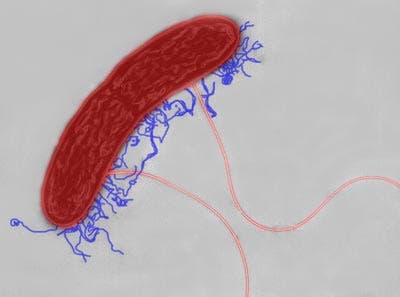A team of researchers from the US claim they have finally found tangible evidence that will once and for all end the controversy surrounding the Geobacter sulfurreducens, a bacteria that conducts electricity along thin protein filaments, just like a metal. In the scientists’ paper, it’s reported that aromatic amino-acids are central to both the electrical and respiratory functions of the bacteria, which funnel electrons up and down “microbial nanowires” using the exact the same principles as the synthetic organic materials used in electronics.

First discovered in 1987, the bacteria initially garnered worldwide attention thanks to its garbage disposal-like ability to “breath” pollutants like iron oxide in mud and wastewater, “exhaling” them into clean byproducts. To achieve this, the bacteria uses fine hair-like filaments, called pili, to funnel electrons along them. These pili are only about 5 nm wide but can be up to 20,000 nm in length, many times the bacteria itself’s length, being highly reminiscent of nanowires.
“For [us], Geobacter‘s behaviour represented a paradigm shift. It goes against all that we are taught about biological electron transfer, which usually involves electrons hopping [or tunnelling] from one molecule to another,” said microbiologist Derek Lovley of the University of Massachusetts Amherst in the US, the lead author of the paper and the scientists who first discovered Geobacter’s pili in 2005.
In order to understand how this highly interesting, yet peculiar, metallic-like conductivity worked, Lovley and his team sought inspiration from organic polymers, whose conductivity is derived from the overlapping pi–pi orbitals of aromatic compound structures. It is through these overlapping ringed structures that electrons flow, which made Lovley hypothesize that maybe in the case of the Geobacter, as well, the aromatic amino acids present in its pili had a major role to play in these unique conductive abilities.
Biological nanowires
To test this idea out, the researchers genetically manipulated the Geobacter to switch aromatic amino acids in key regions with a non-aromatic acid, alanine, in order to see if any change in conductivity occurred – what happened was more than they had bargained for. Physically, the Geobacter looked exactly the same when zoomed under the microscope, but when its electrical conductivity properties were put to the test, it was found that the bacteria’s pili were now terrible at their job.
“It was like pulling the copper out of an extension cord – it still looks the same but it cannot conduct electricity anymore,” Lovley explains.
Moreover, the Geobacter’s ability to dump electrons onto iron oxide in its respiration process was hampered, implying that the conductive pili, and in consequence the aromatic amino-acids, are key to the cell’s biological functions.
“From my perspective, this is huge,” says Lovley, adding that it “really takes away any conjecture that this might not be important in the biological process”.
The idea that a bacteria can conduct electricity like a metal was met with extreme skepticism and subsequent criticism though, and when the idea was proposed initially a few years ago by Lovley a number of reputed scientists bashed the claim. “Trying to be as objective as possible, I cannot think of anybody in the field who accepts the Lovley group’s hypothesis,” said US Naval Research Laboratory researcher Leonard Tender, who published a list of reasons, also in 2012, on why he believes the experiments were flawed.
The main objection lied in whether these conductive capabilities were localized in the pili alone or whether the greater “biofilm” that their linked networks form part of were instead responsible. With these most recent findings reported in a paper published in the journal mBio, Lovley may now have the proof he needs to make his point.
In biology, it has been a controversial idea ever since we proposed it, which is why we are just keeping after it and trying to learn more,” says Lovley
Hopefully, the researchers hope they can soon build a model of the actual electron transport, which would also greatly inspire research on other microbial long-distance electron-transport systems.


